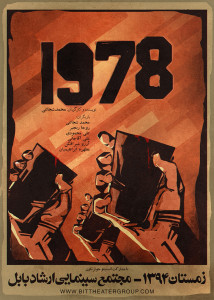 The whole story began with a photograph, one strange photo showing a vast open area filled with a vivid mass of corpses and a masked rescue worker standing above them. The caption spoke about a Mass Suicide in a remote village. Even though I was looking for some samples and parables about suicide for a draft of a writing project about human suicide, this photo was not a turning point on my research process. But I had to talk about this subject with the director/writer Mohammad Shojaei.
The whole story began with a photograph, one strange photo showing a vast open area filled with a vivid mass of corpses and a masked rescue worker standing above them. The caption spoke about a Mass Suicide in a remote village. Even though I was looking for some samples and parables about suicide for a draft of a writing project about human suicide, this photo was not a turning point on my research process. But I had to talk about this subject with the director/writer Mohammad Shojaei.
This may have been the first time I heard the phrase “mass suicide.” And this enigmatic phrase led us to a more enigmatic man named Jim Jones, a beloved and pioneering minister with sunglasses and revolutionary orations who was founder and leader of Peoples Temple. The majority of his followers in Peoples Temple were peaceful religious black people, and Jonestown was a happy and passionate community for which the sun was the main element of their community logo.
At the request of the director, I began my study and research about origins of this event. More details of it emerged and after we translated news and early texts and primary conversations. Collecting documents and tapes, reviewing the artifacts of the story, and selective translating of masses of sermons, texts, articles, interviews and memoirs which has been provided by this website, eventually created the structure of our adaptation of this shocking historical event. While the initial idea was to write a screenplay, that has transformed over time into the format of a documentary play. The political and controversial nature of this story have led Mohammad Shojaei to understand that such a play based on largest mass suicide in modern times would be a stronger piece.
Especially in his recent works, Shojaei has always searched for timeless concepts which seem to repeat over and over in history. The Location and Time are just temporary bodies of these themes and concepts in his world. His main intention is picturing this eternal reincarnation with the language that his audience is familiar with. In fact, his symbolic dramatic language which draws inspiration from modern concerns and patterns is more vivid in his account of 1978 tragedy. Because the script of this play will feature several confessional monologues which transform into dialogues and then trialogues and – in the last scene of play – a multitude of voices, all speaking in a context that is impossible in real life, this drama will set itself apart from a traditional documentary play. That will be in technical contrast with the strong realistic skeleton of this genre. In other words, the sudden confluence of tenses (past and comparative present) for the reconstruction of a historical record in the template he chose to challenge the audience in the final act. More than being an outlier in texture and performance, the play set in 1978 will reach its audience with a postmodern language. The aesthetics of failure had a considerable role in Shojaei’s last works, particularly as an objective pattern in form and performance, and will be continued in structure and language in this effort, as the past slowly approaches the present scene. To put it metaphorically, the last scene is the theater of evocation of Time’s spirit.
Regardless of structural issues, since plays written about such sensitive issues in Iran – much less public performance of them – face serious difficulties and constraints, we decided to complete the pre-production process without any publicity or public attention.
The main idea of this play – which will be on stage in late winter – is not a very new one. It’s just a remembrance. The most important thing for director is the way that this remembrance should be told, to put us in the characters of survivors who were present in Guyana on November 18, former members who had already left Peoples Temple, and families and friends of the Jonestown dead. In this play, they all come back together to tell what they think should be remembered. The original idea of having a physical presence of Jones himself (played by Shojaei on stage) was shelved; instead he will be heard and seen by voices and videos. There are six other characters beside Jones who will tell the story from their own angle, six people whose thoughts and words come from actual narratives of survivors and who will reveal the gray shades within the story of Jim Jones and Jonestown. These characters will speaks on behalf of hundreds of bodies of young and old, white and black, men and women who were buried with thousands of forever unanswered questions, because unlike those innocent dead, history is doomed to be autopsied. In short, this play represents an endeavor to pose some of those fundamental questions.
Perhaps that terrible vivid photograph of the bodies in Jonestown is the common dismal story of generations who – on the way of seeking a hopeful future and a world without war and inequality, filled with happiness and peaceful coexistence – take a step to an arena of Darkness. It is darkness that sometimes is an ominous gift from the light of Hope and the shadow of ignorance, because where there is much light, there is strong shadow, just as Jim Jones, who seemed never to tolerate sunlight, closed the eyelids of his own followers from the sun, forever.
(Mohammad Javad Ghasemi is an Artistic Consultant with the Bit Theater Group in Babol, Iran.)